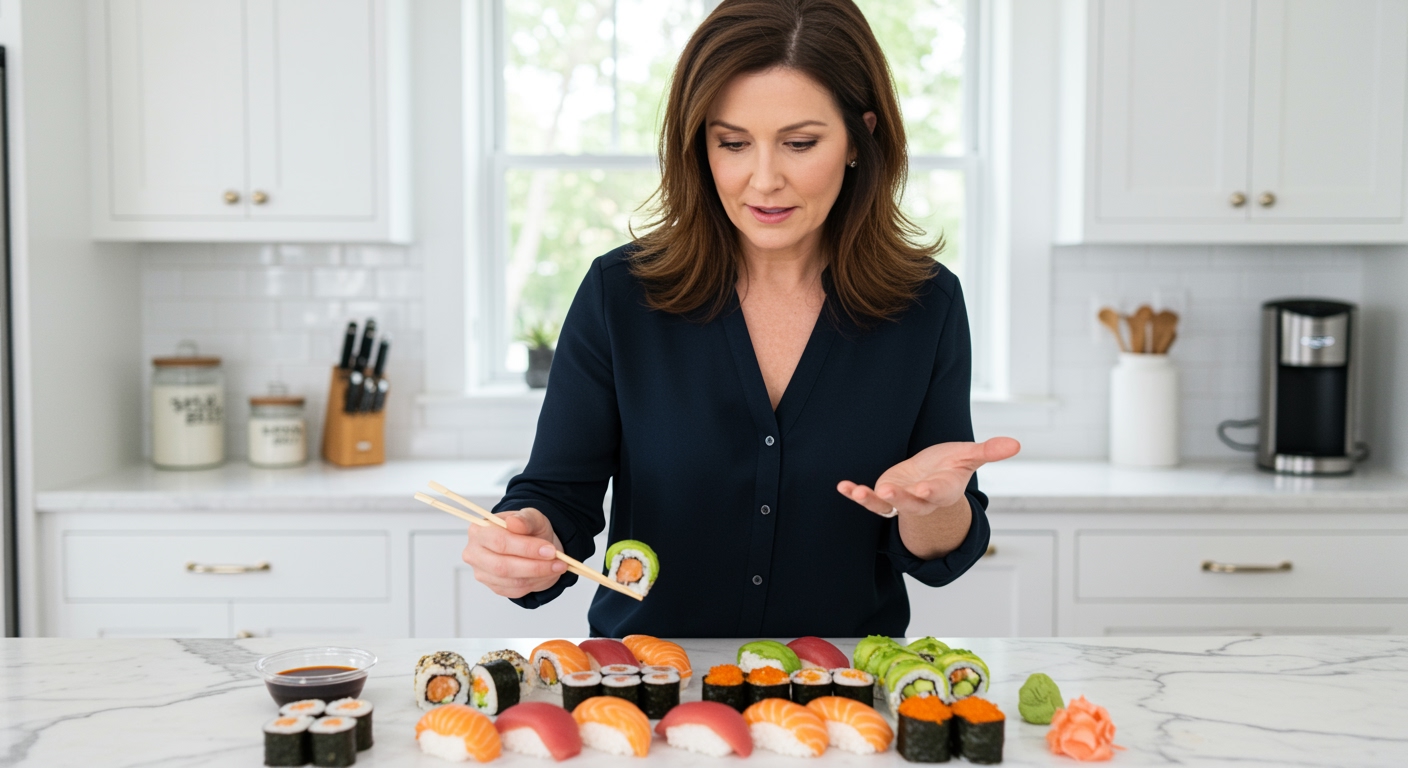✪ Key Takeaway: Sushi can be diabetes-friendly when you choose sashimi, vegetable rolls, and limit white rice portions.
Introduction
You walk into your favorite sushi restaurant and feel that familiar pang of worry about your blood sugar.
Many people with diabetes believe sushi is completely off-limits because of the rice, but this common assumption might be keeping you from enjoying a potentially healthy meal option.
Hi, I’m Abdur, your nutrition coach and today I’m going to explain exactly how sushi affects your blood sugar and which types you can safely enjoy.
How Does Sushi Rice Affect Blood Sugar?
Sushi rice contains short-grain white rice mixed with rice vinegar and sugar, creating a perfect storm for blood sugar spikes.
The glycemic index of sushi rice ranges from 70 to 85, which puts it in the high category that causes rapid glucose elevation.
When you eat sushi rice, your digestive system breaks down the simple carbohydrates within 15 to 30 minutes, sending glucose directly into your bloodstream.
A typical sushi roll contains about 30 to 40 grams of carbohydrates, equivalent to eating two slices of white bread in terms of blood sugar impact.
The added sugar in sushi rice preparation makes this effect even more pronounced, as your body must process both the rice starch and the additional sweeteners simultaneously.
Research shows that people with diabetes experience blood sugar increases of 50 to 100 mg/dL within two hours of eating traditional sushi rolls.
✪ Fact: One California roll contains the same amount of carbs as a small bowl of white rice.
Which Sushi Types Are Diabetes-Friendly?
Sashimi represents the safest sushi option for people with diabetes because it contains zero carbohydrates and provides high-quality protein.
Fresh fish like salmon, tuna, and yellowtail offer omega-3 fatty acids that actually help improve insulin sensitivity and reduce inflammation.
Vegetable-based rolls using cucumber, avocado, or seaweed wraps instead of rice provide fiber and nutrients without the blood sugar spike.
Naruto rolls, which wrap fish and vegetables in thin cucumber slices, eliminate rice completely while maintaining the traditional sushi experience.
Hand rolls or temaki made with nori seaweed and minimal rice offer portion control advantages since they typically contain less rice than traditional rolls.
Brown rice sushi, when available, provides more fiber and has a slightly lower glycemic impact than white rice versions, though it still requires careful portion management.
✪ Pro Tip: Ask your sushi chef to make rolls with half the usual amount of rice to reduce carb content.
What About Protein And Healthy Fats In Sushi?
The protein content in sushi fish helps slow down carbohydrate absorption and provides better blood sugar stability than eating rice alone.
Salmon and tuna contain approximately 20 to 25 grams of complete protein per 3-ounce serving, which helps trigger satiety hormones and reduces overall food intake.
Avocado in sushi rolls provides monounsaturated fats that slow gastric emptying, leading to more gradual glucose release into your bloodstream.
The combination of protein and healthy fats creates a blunting effect on blood sugar spikes, making sushi with these ingredients more diabetes-friendly than pure carbohydrate foods.
Studies demonstrate that meals containing 20 grams of protein can reduce post-meal blood sugar peaks by 20 to 30 percent compared to carbohydrate-only meals.
The omega-3 fatty acids in fish also support insulin sensitivity, helping your cells respond more effectively to insulin over time.
✪ Note: Fatty fish like salmon provides the most blood sugar benefits due to higher omega-3 content.
How Should You Order Sushi With Diabetes?
Start your meal with miso soup or a small salad to help slow down carbohydrate absorption from the rice you might eat later.
Order sashimi as your main course and limit rice-based rolls to one small roll or six pieces maximum to keep carbohydrate intake under control.
Request brown rice when available, or ask for rolls to be made with half the normal rice amount to reduce the glycemic load.
Avoid tempura, spicy mayo, and sweet sauces that add extra carbohydrates and unhealthy fats to your meal.
Choose wasabi and pickled ginger as condiments since they contain minimal carbohydrates and may even help with blood sugar management.
Time your sushi meal appropriately with your medication schedule and consider testing your blood sugar 2 hours after eating to understand your individual response.
✪ Pro Tip: Eat sushi slowly and mindfully to give your body time to register fullness and manage blood sugar better.
The Bottom Line
Sushi can absolutely be part of a diabetes-friendly diet when you make smart choices and practice portion control.
The key to enjoying any food with diabetes is understanding how it affects your body and making informed decisions accordingly.
I would love to hear about your experiences with sushi and diabetes management, so please share your thoughts or questions in the comments below.
References
At NutritionCrown, we use quality and credible sources to ensure our content is accurate and trustworthy. Below are the sources referenced in creating this article:
- Nutrisense: Does Sushi Spike Blood Sugar
- January AI: Glycemic Index Sushi Rice
- Diatribe: Diabetes Friendly Sushi Your Ultimate Guide
- Byram Healthcare: Sushi and Diabetes





